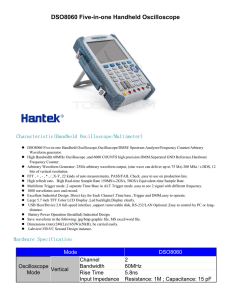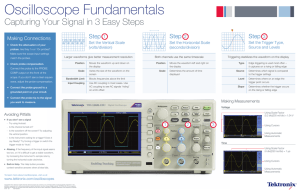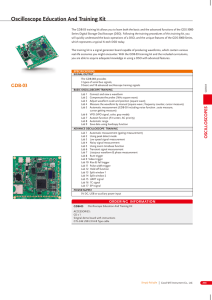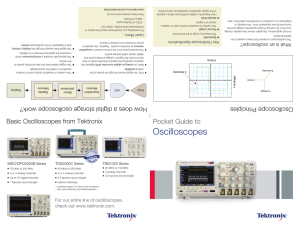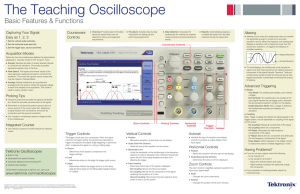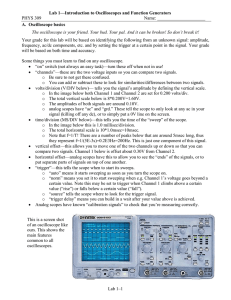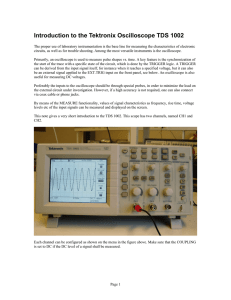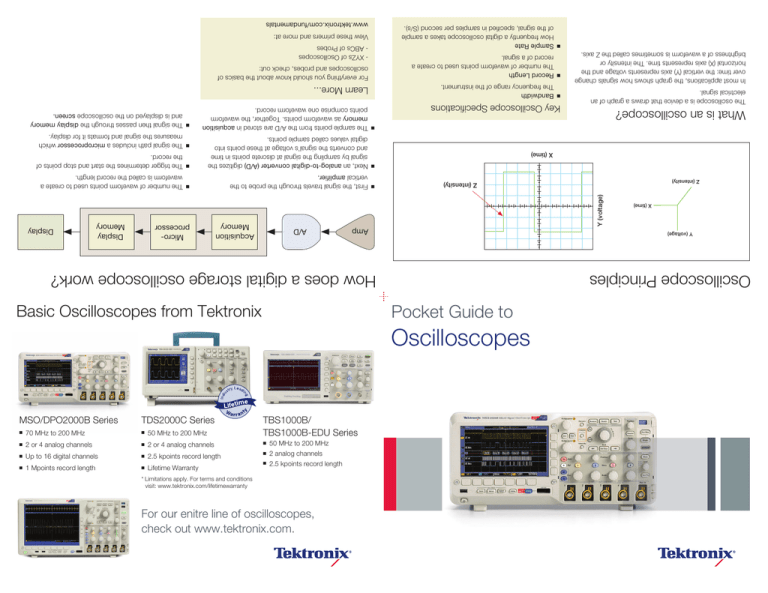
70 MHz to 200 MHz
■
50 MHz to 200 MHz
■
2 or 4 analog channels
■
2 or 4 analog channels
■
■
Up to 16 digital channels
■
2.5 kpoints record length
■
■
1 Mpoints record length
■
Lifetime Warranty
50 MHz to 200 MHz
2 analog channels
■ 2.5 kpoints record length
TBS1000B/
TBS1000B-EDU Series
How does a digital storage oscilloscope work?
Oscilloscope Principles
Y (voltage)
Amp
Acquisition
Memory
A/D
Y (voltage)
Z (intensity)
Z (intensity)
Key Oscilloscope Specifications
■
■
First, the signal travels through the probe to the
vertical amplifier.
Microprocessor
■
■ Next, an analog-to-digital converter (A/D) digitizes the
signal by sampling the signal at discrete points in time
and converts the signal’s voltage at these points into
digital values called sample points.
X (time)
What is an oscilloscope?
The oscilloscope is a device that draws a graph of an
electrical signal.
In most applications, the graph shows how signals change
over time: the vertical (Y) axis represents voltage and the
horizontal (X) axis represents time. The intensity or
brightness of a waveform is sometimes called the Z axis.
TDS2000C Series
X (time)
For our enitre line of oscilloscopes,
check out www.tektronix.com.
* Limitations apply. For terms and conditions
visit: www.tektronix.com/lifetimewarranty
■
MSO/DPO2000B Series
Oscilloscopes
Pocket Guide to
Basic Oscilloscopes from Tektronix
■
■
■ The sample points from the A/D are stored in acquisition
memory as waveform points. Together, the waveform
points comprise one waveform record.
Bandwidth
The frequency range of the instrument.
■
Display
Memory
Display
The number of waveform points used to create a
waveform is called the record length.
The trigger determines the start and stop points of
the record.
The signal path includes a microprocessor which
measures the signal and formats it for display.
The signal then passes through the display memory
and is displayed on the oscilloscope screen.
Learn More...
For everything you should know about the basics of
oscilloscopes and probes, check out:
■ Record Length
The number of waveform points used to create a
record of a signal.
- XYZs of Oscilloscopes
- ABCs of Probes
■ Sample Rate
How frequently a digital oscilloscope takes a sample
of the signal, specified in samples per second (S/s).
View these primers and more at:
www.tektronix.com/fundamentals
Oscilloscope Front Panel
3. Trigger Controls
3 Main Sections:
Trigger controls allow you to capture single-shot
waveforms and stabilize repetitive waveforms.
2
Imagine the jumble on the screen that would result if each
time the trace is drawn across the screen, the drawing
begins at a different part of the waveform. The trigger
ensures the same part of the waveform is drawn each
time, making repetitive waveforms appear static.
Horizontal Controls
Threshold: +
slope: +
Untriggered Display
Vertical Controls
3
Triggered Display
Trigger level and slope
■
■
The slope control determines whether the trigger point
is on the rising edge (positive slope) or the falling edge
(negative slope) of a signal.
The level control determines where on the edge the
trigger point occurs.
Source
■
1. Vertical Controls
2. Horizontal Controls
Position and Volts-Per-Division (Volts/Div)
Position and Seconds-Per-Division
(Sec/Div)
■
■
The vertical position control allows you to move the
waveform up and down on the display.
The volts-per-division (volts/div) setting varies the size
of the waveform on the screen. The volts/div setting
is a scale factor. If the volts/div setting is 5 volts, then
each vertical division represents 5 volts and an entire
screen of 8 divisions can display 40 volts from top
to bottom.
Input Coupling
Determines which part of the signal presented to the
oscillscope's input is displayed on the screen.
■
■
■
■
■
The horizontal position control allows you to move
the waveform left and right on the display.
The seconds-per-division (sec/div) setting varies
the rate at which the waveform is drawn across
the screen (also known as the time base setting or
sweep speed). The sec/div setting is a scale factor.
If the setting is 1 ms, then each horizontal division
represents 1 ms and the entire screen of 10 divisions
represents 10 ms.
DC coupling shows all of an input signal.
AC coupling blocks the DC component of a signal
so that you see the waveform centered around
zero volts.
Ground coupling disconnects the input signal from the
vertical system, which lets you see where zero volts is
located on the screen.
Copyright © 2014, Tektronix. All rights reserved. Tektronix products are covered by U.S. and foreign patents, issued and pending. Information in this publication supersedes that in all previously
published material. Specification and price change privilegesreserved. TEKTRONIX and TEK are registered trademarks of Tektronix, Inc. All other trade names referenced are the service
marks, trademarks or registered trademarks of their respective companies.
04/14 EA/WWW 3GW-20181-5
Threshold: slope: +
Determines whether or not the oscilloscope draws a
waveform based on a signal condition.
■
The trigger circuit acts as a comparator. When the signal
matches the trigger setting, the oscilloscope generates a
trigger and captures a signal. Edge triggering is used most
often; it captures the signal on a rising or falling edge.
Trigger Controls
Threshold: slope: -
Modes
■
1
Threshold: +
slope: -
■
Normal mode - the oscilloscope only sweeps if the
input signal reaches the set trigger point; otherwise
the screen is frozen on the last acquired waveform.
Auto mode - the oscilloscope sweeps, even without
a trigger. If no signal is present, a timer in the
oscilloscope triggers the sweep. This ensures that
the display will not disappear if the signal does not
cause a trigger.
Single sequence mode - After the oscilloscope detects
a trigger, the oscilloscope acquires and displays one
triggered screen of a signal and then stops.
Coupling
Similar to vertical coupling. High frequency, low frequency,
and noise rejection trigger coupling are useful for eliminating
noise from the trigger signal to prevent false triggering.
Determines which signal is compared to the
trigger settings.
Tips for Capturing your Signal
1. Return the oscilloscope to a known state.
Press the Default Setup button.
If your waveform is indistinguishable, adjust the
horizontal scale.
2. Connect the appropriate probe to the oscilloscope.
- Check that the oscilloscope and probe
bandwidths match.
- Check probe compensation.
■
If you can not get a stable trace, check the following:
■
3. Connect your probe to the circuit signal.
When using an oscilloscope, you need to adjust three
basic settings to accommodate an incoming signal:
- The vertical scale (volts/div).
- The time base / horizontal scale (sec/div).
- The trigger level, slope, source, mode, and type.
If you do not see a signal, check the following:
■
■
Is the channel on?
Is the waveform off screen?
- Adjust the vertical position and scale.
- Adjust vertical coupling if signal has large DC
component.
■
■
Trigger level and source.
For waveforms with events far apart in time, use
normal mode.
For single shot events, use single sequence mode.
When using two or more traces, one trace may
be stable while the others keep racing across
the display. The frequencies of the waveforms
are different.
- Change trigger source to characterize each
signal individually.
- Or, use single sequence mode.
step 1
step 2
Pocket Guide to
Signal Sources
step 3
Pocket Guide to
Signal Sources
Pocket Guide to
Signal Sources
2. Fold the guide in half with a horizontal fold
1. Print the four-panel guide on both
sides of a single sheet of paper
3. Fold the guide in half with a vertical fold


